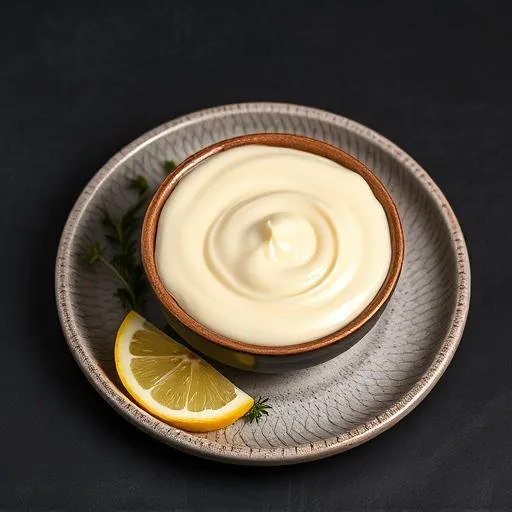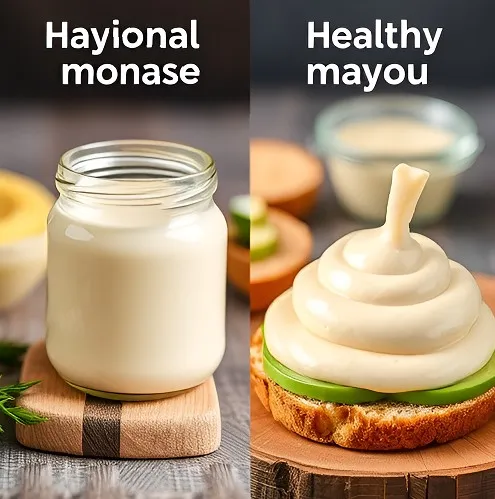Okay, so you love mayonnaise, right? That creamy, tangy stuff that makes sandwiches sing and dips dance. But, let’s face it, standard mayo often gets a bad rap. It’s usually loaded with fats and calories, making it a no-go for some folks watching their diets. But what if you could have your mayo and eat it too? This article is about healthy mayonnaise, the kind that doesn’t make you feel guilty. We’ll break down what makes regular mayonnaise less than ideal, show you how to spot good-for-you options in stores, and even walk you through making your own at home. Plus, we’ll give you plenty of ideas on how to use it, so you can enjoy all that creamy goodness without the downsides. Get ready to rethink mayo!
Table of Contents
Understanding the Traditional Mayonnaise Dilemma
What is Traditional Mayonnaise and Why Is It Viewed as Unhealthy?
Traditional mayonnaise, as most know it, is a pretty simple emulsion of oil, egg yolks, and an acid, like vinegar or lemon juice. However, it’s the type of oil and the additional ingredients that often make it a dietary downfall. Standard mayo is usually made with refined vegetable oils that aren’t the best for your health. These oils are often high in omega-6 fatty acids, which can be inflammatory if consumed in excess. Moreover, these are usually stripped of their natural nutrients.
The High Fat Content and Calorie Concerns of Standard Mayo
Indeed, one of the biggest concerns about traditional mayonnaise is its high fat and calorie content. Because it’s primarily made of oil, even a small serving can pack a significant number of calories and grams of fat. For people watching their weight or aiming for a specific macronutrient balance, this can be a major stumbling block. This high concentration of fats means that even small additions to meals can seriously affect daily caloric goals.
The Problematic Ingredients: Refined Oils, Additives, and Preservatives
Apart from the type of oil, traditional mayo often contains various additives and preservatives. These are usually included to extend shelf life and improve texture, but they might not be what you want to put into your body. Things like artificial flavors, added sugars, and some preservatives might cause concerns for people with sensitivities or allergies. In other words, it is not just the fat that raises eyebrows.
Why Do People Love Mayo? The Flavor Profile and Cultural Significance
Despite all its potential downsides, mayo is still incredibly popular. It has a unique creamy texture and tangy flavor profile that makes many foods more enjoyable. In addition, mayonnaise is culturally significant, appearing in countless recipes across different countries and cuisines. It’s a go-to condiment that adds moisture, richness, and a bit of zing. From sandwiches and salads to dips and sauces, mayo has a special place in the hearts and kitchens of many.
Defining “Healthy Mayonnaise”: Key Characteristics and Considerations

What Makes Mayonnaise “Healthy”? Focusing on Key Attributes
So, what exactly makes healthy mayonnaise different from the regular stuff? Well, it comes down to a few key features. First and foremost, the type of fat used is crucial. Instead of relying on refined vegetable oils, healthy mayonnaise options focus on sources that are good for you. In addition, the ingredient list should be short and easy to understand. Ideally, healthy mayo is made with simple, wholesome ingredients.
The Shift Towards Healthier Fat Sources: Olive Oil, Avocado Oil, and More
This brings us to the point: the kind of oil used in mayo matters. Olive oil mayonnaise and avocado oil mayo are becoming more popular for good reason. These oils contain monounsaturated fats, which are known to support heart health. Moreover, oils like avocado and macadamia also provide other nutrients. So, a switch to these oils can make a big difference in the nutritional value of your mayo.
Minimizing Additives, Preservatives, and Artificial Ingredients
Another important factor is the absence of unnecessary additives. A truly healthy mayonnaise should avoid artificial flavors, colors, and preservatives as much as possible. The goal is to find options with a clean ingredient list, and simple ingredients. This way, you know exactly what you’re eating and can feel good about it. It really is about keeping things as natural as possible.
Lowering Sodium and Sugar Content: A Key Consideration
Even seemingly small things like sodium and sugar content can impact how healthy your mayonnaise is. Many commercial mayos sneak in extra sodium and even a bit of sugar to improve taste or shelf life. Choosing a brand with lower amounts, or even making your own, allows you to have better control. Healthy mayonnaise options are typically lower in both, so you can use it without the worry.
The Importance of Egg Source: Pastured vs. Conventional
Finally, let’s talk about eggs. The source of the eggs used to make mayonnaise also plays a role in its overall health value. Pastured eggs from chickens allowed to roam and eat their natural diet are often richer in vitamins and nutrients compared to conventional eggs. It is a small detail, but it is something worth thinking about if you make your own mayonnaise.
Top Healthy Mayonnaise Alternatives: Store-Bought Options

Review of Popular “Healthy” Mayo Brands on the Market
These days, you’ll find a bunch of brands that market themselves as healthy mayonnaise. Some popular ones include those made with avocado oil, olive oil, or even plant-based alternatives. It’s a big step up from the old mayo of the past, which mostly used refined oils. Many brands now focus on using better ingredients, which is great for folks who want to make smarter choices. However, not all healthy mayo brands are equal.
Analyzing Ingredient Lists: Deciphering Labels and Making Informed Choices
Before you grab any healthy mayonnaise off the shelf, be sure to read those labels carefully! Look for short ingredient lists with recognizable items. Steer clear of stuff you can’t pronounce or that sounds artificial. Also, pay close attention to the type of oil used. Avocado oil and olive oil mayonnaise are generally good picks. This really makes a difference in your diet.
Assessing Nutritional Profiles: Calories, Fat Content, and Key Nutrients
Once you’ve checked out the ingredients, it’s time to look at the nutrition info. This can tell you a lot about the product. Compare the calorie count, fat content (especially saturated fats), and sodium levels of different brands. Remember, healthy mayonnaise should be lower in sodium and have a good balance of fats, particularly those that are considered better for heart health.
Taste Tests: Comparing the Flavor and Texture of Various Brands
Of course, a healthy mayonnaise also has to taste good, right? Flavor and texture can really differ quite a bit across brands. Some olive oil mayos, for example, might have a stronger flavor that you might not always want. So, it is always a good idea to try a few brands to see what you like best.
Plant-Based Mayo Options: Exploring Vegan and Egg-Free Alternatives
If you’re vegan or just not into eggs, you’re in luck! There are some very delicious plant-based mayo options on the market. These are usually made from things like soy, aquafaba (the liquid from canned chickpeas), or cashews. These offer a great way to get that mayo-like texture and flavor without animal products. Moreover, they can be just as creamy and tasty, which is really cool.
For more delicious plant-based recipes, check out our Avocado Chocolate Mousse Recipe.
The Joy of Homemade Healthy Mayonnaise: Recipes and Methods

Basic Recipe for Homemade Healthy Mayo Using Olive Oil
Making your own healthy mayonnaise at home is easier than you might think! A basic recipe calls for just a few ingredients: one egg yolk (use a pastured egg if possible!), about a cup of olive oil, a tablespoon of lemon juice or vinegar, and a pinch of salt. This is the perfect starting point for a delicious homemade mayo.
Step-by-step instructions for the perfect homemade healthy mayonnaise.
To make this homemade healthy mayonnaise, start by placing the egg yolk, salt, and lemon juice in a bowl. Whisk these ingredients together until they’re combined. Then, slowly drizzle in the olive oil while whisking constantly. It’s important to add the oil little by little, so the mixture emulsifies properly and becomes thick and creamy. It really does take a bit of patience, but the results are so worth it.
Tips and Tricks to Avoid Common Failures in Homemade Mayonnaise
One common mistake is adding the olive oil too quickly, which can cause your mayo to break. Always add the oil in a slow, steady stream and whisk constantly. Also, make sure all your ingredients are at room temperature for the best results. If your mayo does break, don’t worry; you can often save it by adding a bit more lemon juice or another egg yolk.
Variations on the Classic: Adding Herbs, Spices, and Other Flavors
The beauty of homemade mayo is that you can make it your own. Try adding minced garlic, fresh herbs like dill or basil, or a touch of Dijon mustard for extra flavor. Some people even add a dash of hot sauce for a little kick. The sky’s the limit when it comes to making it more exciting.
Exploring different oil bases like avocado or macadamia oil for homemade mayonnaise.
Olive oil is a great start, but feel free to experiment with other healthy oils. Avocado oil, for example, has a milder flavor and is another good source of healthy fats. Macadamia oil is also great if you can find it. Each oil has its own flavor that will make your homemade mayonnaise unique.
Vegan Healthy Mayonnaise Recipes: Using Aquafaba and Other Alternatives
For a vegan healthy mayonnaise, you can use aquafaba, the liquid from canned chickpeas. Simply whisk the aquafaba until it forms soft peaks and then slowly drizzle in your choice of oil while whisking, just like with egg yolks. Add lemon juice, salt, and any flavorings you like, and you’ll have a surprisingly tasty, egg-free mayo.
Incorporating Healthy Mayonnaise Into Your Diet: Uses and Applications
Beyond Sandwiches: Innovative Ways to Use Healthy Mayo in Recipes
Healthy mayonnaise isn’t just for sandwiches anymore. It is actually super versatile! Use it as a base for creamy dips, add it to potato or pasta salads, or put a dollop on top of grilled fish or chicken for some extra flavor. You can even use it to create creamy sauces for many different dishes.
Healthy Mayonnaise as a Base for Dips, Dressings, and Sauces
Healthy mayo makes a fantastic base for lots of different dips. Mix it with some yogurt or sour cream, then add spices, herbs, or roasted vegetables for a quick and tasty dip. For salad dressings, you can thin out healthy mayo with some lemon juice, vinegar, or a little water, and then add other flavorings as desired. It is very simple to make many different sauces.
Using Healthier Mayo in Classic Dishes: Salad Recipes, Potato Salads, and More
Many classic dishes taste way better with healthy mayonnaise. Try using olive oil mayo in your next potato salad for a healthier, more flavorful version. You can also use it in chicken salad, egg salad, or even coleslaw. These simple swaps can make a big difference in how you enjoy classic meals.
Substituting Regular Mayo with a Healthy Version: Taste and Texture Considerations
When switching from regular mayo to a healthier mayonnaise, you might notice some subtle differences in taste and texture. Olive oil mayo may have a slightly stronger flavor, while plant-based options might have a slightly different mouthfeel. However, with a bit of experimenting, you’ll find the perfect way to use healthy mayo in your favorite recipes.
Tips for Portion Control and Balanced Meal Planning
Even though it is healthy mayonnaise, it’s important to keep portion sizes in mind. While using healthier mayo options is a step in the right direction, it’s still important to include it as part of a balanced diet. Remember, even good fats should be eaten in moderation.
Healthy Mayonnaise: Common Myths and Misconceptions
Debunking the Myth that All Fats are Bad: Understanding Healthy Fats
It’s important to understand that not all fats are created equal. Healthy mayonnaise, particularly those made with avocado oil or olive oil, contain good fats that are actually good for your body. Monounsaturated and polyunsaturated fats are essential for brain function, heart health, and even help you absorb certain vitamins. It really is about choosing the right kinds of fats.
Addressing Concerns About the Healthiness of Homemade Mayo
Some folks may worry about the safety of homemade mayonnaise, especially because it uses raw eggs. However, if you use fresh, pasteurized eggs and consume the mayo within a few days, it’s generally considered safe. Remember to follow all the food safety guidelines. Also, there are some egg-free options, as we discussed earlier.
Clearing Confusion About Cholesterol and Egg Consumption
The link between egg yolks and cholesterol has been misunderstood for a while. Current research shows that dietary cholesterol doesn’t have a big effect on blood cholesterol for most people. So, if you’re making healthy mayonnaise with whole eggs, don’t worry about it too much, unless you have specific health concerns.
Frequently Asked Questions About Healthy Mayonnaise (FAQs)
Is healthy mayonnaise really healthier than regular mayo?
Yes, healthy mayonnaise options are typically better for you than traditional mayonnaise. They tend to be lower in sodium, added sugar, and saturated fats. They also use healthier oils like olive oil or avocado oil. So, choosing healthy mayo can actually make a difference.
Can I use olive oil to make mayonnaise and keep it from being bitter?
Yes, you can, however, some people find that olive oil mayonnaise can sometimes have a bitter taste. To avoid this, use a light or mild olive oil. Also, don’t over-whisk the mayonnaise; this can also make it bitter. Experiment to get it just right.
How long does homemade healthy mayonnaise last in the refrigerator?
Homemade healthy mayonnaise will last for about 3-4 days in the refrigerator when stored in a clean, airtight container. Be sure to smell it before using it. If it has an off-putting smell or texture, throw it away to be safe.
What are the best plant-based healthy mayonnaise alternatives?
Some really good plant-based options include mayo made from aquafaba, cashews, or soy. There are several brands and recipes available. These offer a great way to enjoy mayo without using eggs. Each has a slightly different taste and texture, so it really does come down to your preference.
Are there any low-calorie mayonnaise options?
Yes, some brands make low-fat mayonnaise options or light mayonnaise. These usually have fewer calories than regular mayo because they use less oil. But, also check their ingredient list. Just because a product is low-calorie, it may have other ingredients you don’t want.
Can I use healthy mayonnaise in cooking or is it only for cold dishes?
While it’s most often used in cold dishes, you can also add healthy mayonnaise to some warm dishes at the very end of the cooking process. For example, some cooks mix mayonnaise into the top of casseroles or soups. But, it is best to avoid high heat as this can cause it to separate.

